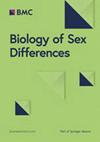静息心率与暴力暴露和创伤后应激症状的关系:儿童的性别差异
IF 4.9
2区 医学
Q1 ENDOCRINOLOGY & METABOLISM
引用次数: 0
摘要
童年时期经历的创伤事件会导致成年后罹患心血管疾病的风险增加。美国黑人受到的影响尤为严重,因为他们经历童年创伤和成年后患心血管疾病的风险更高。这种关联的假设机制之一是自律神经系统的长期失调,这是创伤后应激障碍(PTSD)的标志性生理生物标记,女性的发病率是男性的两倍。我们在佐治亚州亚特兰大市和密歇根州底特律市的研究中心招募了 91 名 9 岁的美国黑人儿童,作为儿童发展纵向研究的一部分。通过使用 Biopac MP150 记录心电图(ECG)测量静息心率。研究人员对暴力暴露和创伤后应激障碍症状进行了自我报告测量。接触暴力较多的儿童报告的创伤后应激障碍症状增加,静息心率降低。回归分析表明,性别会改变这种关系(B = -0.64,P < 0.05),因此女孩静息心率与创伤后应激障碍之间的关系比男孩更密切。在我们使用静息心率的标准临床临界值进行的探索性分析中,我们发现标准心率组能显著缓和男孩(B = -2.14,p < 0.01)和女孩(B = -0.94,p = 0.27)的暴力暴露与 PTSS 之间的关系。在以城市黑人儿童为主的样本中,我们发现暴力暴露与更慢、更像成人的心率有关,女孩表现出更大的 PTSS 与更慢的心率有关,而男孩则没有,与心率正常的女孩相比,心率低于正常的女孩表现出明显更高的 PTSS。除生理影响外,我们的样本还显示了心理后果,这可能为暴力暴露的心理生物学后遗症提供了新的信息。童年时期经历创伤事件可能会导致成年后罹患心脏病的风险增加。发生这种情况的途径之一是自律神经系统的长期变化。创伤后应激障碍(PTSD)会导致自律神经系统失调,而女性患这种疾病的几率是男性的两倍。我们探讨了静息心率(HR)这一衡量自律神经功能的指标是否与儿童遭受暴力侵害有关,以及这种关系在男孩和女孩中是否有所不同。我们还探讨了根据标准化的心率标准将样本分为静息心率组是否能预测暴力暴露与创伤后应激症状(PTSS)之间的不同关系。由于童年创伤和心脏病对美国黑人的影响更大,我们从佐治亚州亚特兰大市和密歇根州底特律市的研究中心招募了 92 名 9 岁儿童作为样本。我们测量了他们的静息心率、暴力暴露和 PTSS。我们发现,暴力暴露与总体心率降低有关,与男孩相比,女孩的 PTSS 与心率降低有关,而心率低于正常水平的男孩与心率正常的男孩相比,暴力暴露与 PTSS 之间的关联更强。未来的研究应探讨这种性别差异的潜在机制,以便更好地了解与性别相关的健康差异对心血管造成的长期影响。具体来说,纵向研究可能有助于研究人员了解青少年时期心率降低是如何导致未来心血管疾病和精神病理学的。本文章由计算机程序翻译,如有差异,请以英文原文为准。
Resting heart rate associations with violence exposure and posttraumatic stress symptoms: sex differences in children
Traumatic events experienced in childhood can lead to increased risk of cardiovascular disorders in adulthood. Black Americans are disproportionately affected, as they are at increased risk for experiencing childhood trauma and cardiovascular diseases in adulthood. One of the hypothesized mechanisms of this association is through long-lasting dysregulation of the autonomic nervous system, a hallmark physiological biomarker of posttraumatic stress disorder (PTSD), which is twice as prevalent in women compared to men. Ninety-one, majority Black American children, aged 9 were recruited to be a part of our longitudinal study of child development at research centers in Atlanta, GA and Detroit, MI. Resting HR was measured through a electrocardiogram (ECG) recording using the Biopac MP150. Self-report measures of violence exposure and PTSD symptoms were administered by research staff. Children with more violence exposure reported increased PTSS as well as lower resting HR. Regression analysis showed evidence of sex modifying this relationship, (B = -0.64, p < 0.05), such that the association between resting HR and PTSS was stronger in girls than in boys. In our exploratory analysis with standard clinical cutoffs of resting HR, the normative HR group was found to significantly moderate the relationship between violence exposure and PTSS in boys, (B = -2.14, p < 0.01), but not girls (B = -0.94, p = 0.27). In our sample of primarily Black urban children, we found that violence exposure was associated with slower, more adult-like HR, that girls showed greater PTSS associated with slower HR while boys did not, and that girls with lower than normative HR showed significantly higher PTSS compared to girls with normative HR. Our sample’s demonstration of psychological consequences in addition to the physiological implications could provide new information about a psychobiological sequelae of violence exposure. Experiencing traumatic events in childhood can lead to increased risk of heart disease in adulthood. One of the ways this might happen is through long-lasting changes of the autonomic nervous system. This system is dysregulated in posttraumatic stress disorder (PTSD), which is twice as common in women compared to men. We explored whether resting heart rate (HR), a measure of autonomic functioning was associated with violence exposure in children, and whether this relationship was different in boys and girls. We also explored whether categorizing our sample into resting HR groups based off standardized norms for HR predicted differing relationships between violence exposure and posttraumatic stress symptoms (PTSS). Because childhood trauma and heart disease impact Black Americans at greater rates, we recruited our sample of 92 nine-year-old children from research centers in Atlanta, GA and Detroit, MI. We measured their resting HR, exposure to violence, and PTSS. We found that violence exposure was associated with lower HR overall, that girls showed greater PTSS associated with lower HR when compared to boys, and that boys with lower than normative HR showed a stronger association between violence exposure and PTSS compared to boys with normative HR. Future studies should examine potential mechanisms underlying this sex difference to best understand the long-term cardiovascular consequences for sex-related health disparities. Specifically, longitudinal studies may be able to help researchers understand how reduced HR during adolescents might lead to future cardiovascular disease and psychopathology.
求助全文
通过发布文献求助,成功后即可免费获取论文全文。
去求助
来源期刊

Biology of Sex Differences
ENDOCRINOLOGY & METABOLISM-GENETICS & HEREDITY
CiteScore
12.10
自引率
1.30%
发文量
69
审稿时长
14 weeks
期刊介绍:
Biology of Sex Differences is a unique scientific journal focusing on sex differences in physiology, behavior, and disease from molecular to phenotypic levels, incorporating both basic and clinical research. The journal aims to enhance understanding of basic principles and facilitate the development of therapeutic and diagnostic tools specific to sex differences. As an open-access journal, it is the official publication of the Organization for the Study of Sex Differences and co-published by the Society for Women's Health Research.
Topical areas include, but are not limited to sex differences in: genomics; the microbiome; epigenetics; molecular and cell biology; tissue biology; physiology; interaction of tissue systems, in any system including adipose, behavioral, cardiovascular, immune, muscular, neural, renal, and skeletal; clinical studies bearing on sex differences in disease or response to therapy.
 求助内容:
求助内容: 应助结果提醒方式:
应助结果提醒方式:


